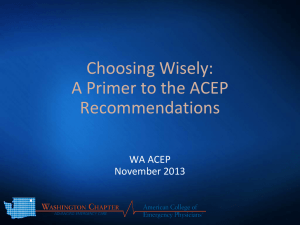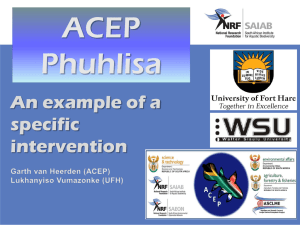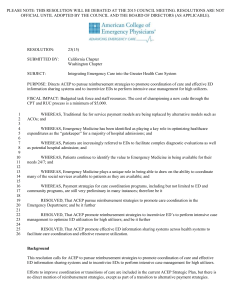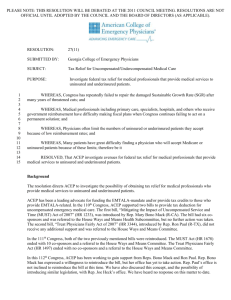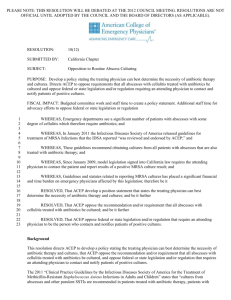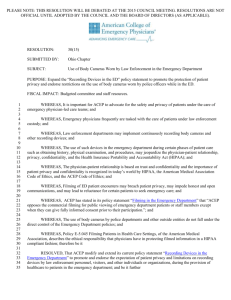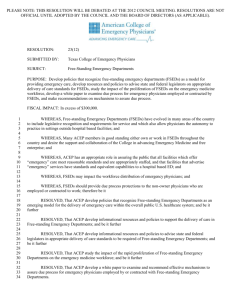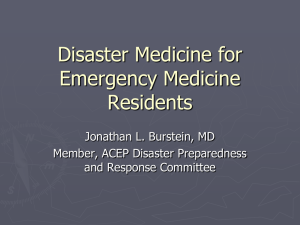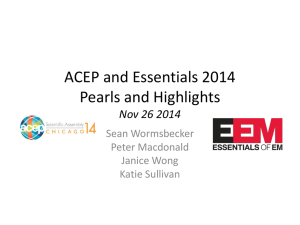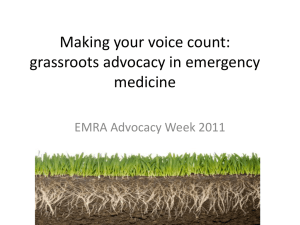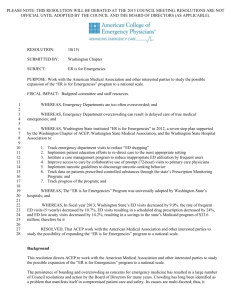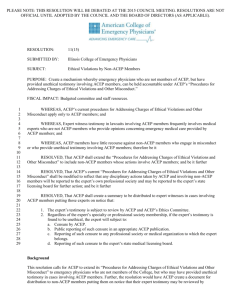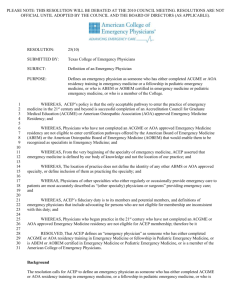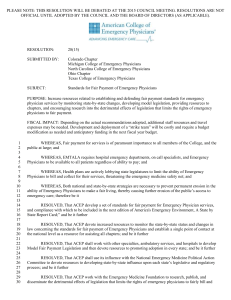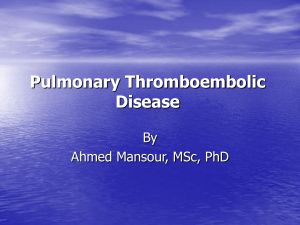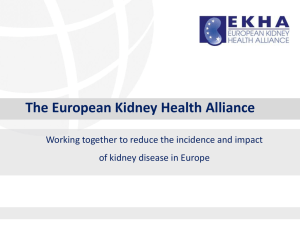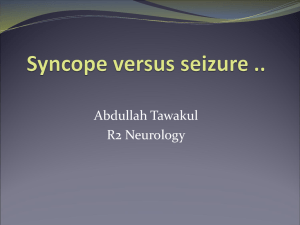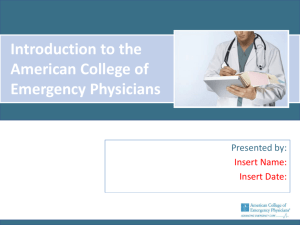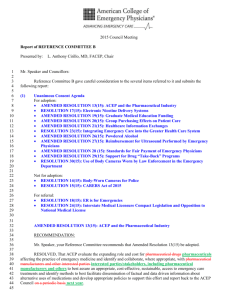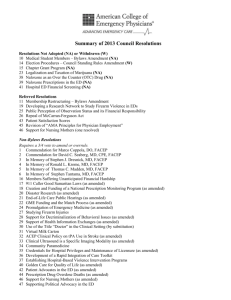Title of Presentation
advertisement
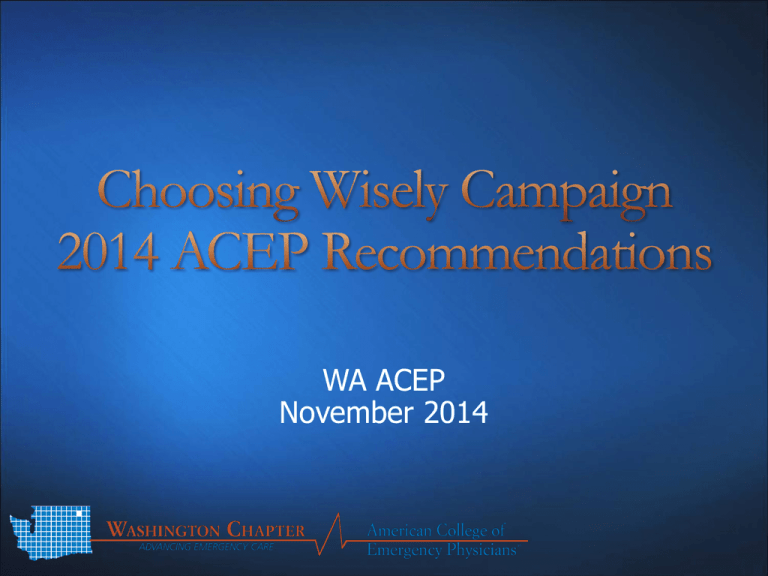
WA ACEP November 2014 • Disclaimers • Introduction – Choosing Wisely Campaign II • 2014 ACEP Recommendations – Avoid: • CT scan of the head for asymptomatic adults with syncope, minor trauma, & normal neurological exam • CT pulmonary angiography if low-pretest probability of PE and either a negative PERC score or D-dimer • Lumbar spine imaging for atraumatic back pain • Antibiotics for uncomplicated sinusitis • CT KUB for young otherwise healthy patients with known histories of kidney stones • Conclusion • The following tests and procedures were recommended for inclusion in the “Choosing Wisely” campaign in 2014 by an expert panel of emergency physicians and the ACEP Board of Directors because they may not be cost effective in some situations. • However, these recommendations should not be construed or used to supersede the decision of the responsible provider, who possesses the knowledge, clinical judgment, and the situational awareness of the context and availability of appropriate resources. • The following summaries are intended to serve as a guide and facilitate increased awareness, but only represent a portion of the available information and references. Providers are encouraged to incorporate any and all references available prior to implementation in clinical practice. • The authors of this presentation have no relevant conflicts of interest to disclose. • Originally conceived and piloted by the National Physicians Alliance along with Consumer Reports • Endorsed by the ABIM Foundation and over 20 medical specialty organizations • Identify tests and procedures commonly used in their field whose necessity should be questioned OR discussed with patients • First set of recommendations released in Nov 2013 http://www.choosingwisely.org/ http://www.abimfoundation.org/Initiatives/Choosing-Wisely.aspx • ACEP declined initial participation in 2012 because: • the impact on the unique nature of emergency medicine, liability concerns, and potential harm to physician reimbursement had not yet been appropriately examined, and • any tests and procedures identified should be evidenced-based and have meaningful contribution to cost-effective care. • In February 2013, after review by an expert panel of emergency physicians, the ACEP Board of Directors elected to participate in the campaign and recommended the first five tests and procedures. http://thecentralline.org/?p=2723 http://www.acep.org/Clinical---Practice-Management/ACEP-Announces-List-ofTests-As-Part-of-Choosing-Wisely-Campaign/ Avoid computed tomography (CT) of the head in asymptomatic adult patients in the emergency department (ED) with syncope, insignificant trauma, and a normal neurological evaluation. • Syncope or near syncope is a common reason for visiting an ED and most of these visits are not serious. Many tests may be ordered to identify the cause of the problem. • However, these tests should not routinely ordered, and the decision to order them should be guided by information obtained from the patient’s history or physical examination. • Clinical Study – 2005 • http://link.springer.com/article/10.1007/s10140-005-0434z#page-1 • Clinical Study - 2007 • http://link.springer.com/article/10.1007/s11739-007-00105#page-1 • ACEP Clinical Policy – 2007 • http://www.annemergmed.com/article/S01960644(07)00130-8/abstract Avoid CT pulmonary angiography in ED patients with a low-pretest probability of pulmonary embolism and either a negative Pulmonary Embolism Rule-Out Criteria (PERC) or a negative D-dimer. • Advances in medical technology have increased the ability to diagnose even small blood clots in the lung. Now, the most commonly used test is known as a CT pulmonary angiography (CTPA). It is readily available in most hospitals and EDs. • However, disadvantages of the CTPA include patient exposure to radiation, the use of dye in the veins that can damage kidneys, and high cost. • Clinical Study – 2010 • http://www.annemergmed.com/article/S01960644(10)00276-3/fulltext • ACEP Clinical Policy – 2011 • http://www.annemergmed.com/article/S01960644(11)00097-7/abstract • Meta-Analysis – 2012 • http://www.annemergmed.com/article/S01960644(11)01761-6/fulltext • Journal Club – 2012 • http://www.annemergmed.com/article/S01960644(12)01370-4/fulltext Avoid lumbar spine imaging in the ED for adults with atraumatic back pain unless the patient has severe or progressive neurological deficits or is suspected of having a serious underlying condition, such as vertebral infection or cancer with bony metastasis. • Low back pain without trauma is a common presenting complaint in the ED. • Most of the time, such pain is caused by conditions such as a muscle strain or bulging disc that cannot be identified on an x-ray or CT scan. • Epidemiological Study - 2010 • http://www.ncbi.nlm.nih.gov/pmc/articles/PMC2982879/ • Review Article – 2010 • http://www.mdconsult.com/das/article/body/4718697853/jorg=journal&source=MI&sp=23728018&sid=1554383254/N/770100/s 0733862710000465.pdf?SEQNO=1&issn=0733-8627 • ACR Appropriateness Criteria Low Back Pain – 2011 • http://www.guideline.gov/content.aspx?id=35145 Avoid prescribing antibiotics in the ED for uncomplicated sinusitis. Most patients with acute sinusitis do not require antibiotic treatment, because 98% of acute sinusitis cases are caused by a viral infection and resolve in 10-14 days without treatment. • Special Report - CDC Principles of Judicious Antibiotic Use - 2001 • http://www.annemergmed.com/article/S01960644(01)70089-3/fulltext • Clinical Study – 2011 • http://archinte.jamanetwork.com/article.aspx?articleid=110 8815 Avoid ordering CT of the abdomen and pelvis in young otherwise health ED patients with known histories of ureterolithiasis presenting with symptoms consistent with uncomplicated kidney stones. • Many patients < 50 years old who have symptoms of recurrent kidney stones do not need a CT scan unless symptoms persist/worsen, there is a fever, or a history of solitary kidney or severe obstruction. • CT scans of patients with symptoms suggestive of recurrent kidney stones usually do not change treatment, and the cost and radiation exposure can often be avoided in these cases. • Clinical Study – 2010 • http://www.mdconsult.com/das/article/body/4718697858/jorg=journal&source=MI&sp=23007066&sid=155438772 7/N/739797/s073567570800819x.pdf?issn=0735-6757 • Epidemiological Study - 2013 • http://www.nature.com/ki/journal/v83/n3/full/ki2012419a.ht ml
